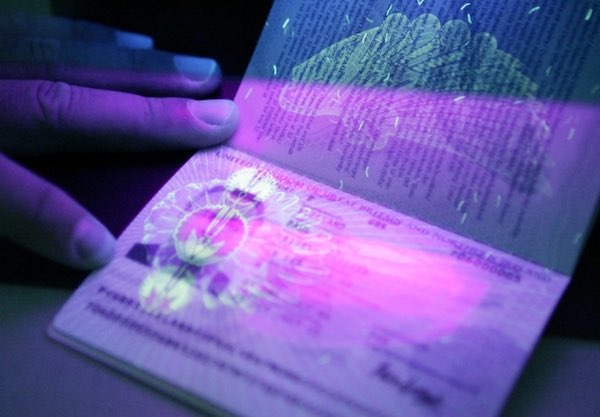
[Image above] A novel ceramic nanoparticle ink composed of europium-doped zirconia nanocrystals may provide a robust new method for security printing. Credit: ITMO University
In our increasingly global, mobile, and digital society, security is a huge consideration.
Just last month, hackers stole some of my personal credit card information and went on a digital shopping spree—filling their shopping carts on websites for Academy Sports, J.C. Penney, Cabela’s, and Macy’s.
I’m one of many. U.K.-based anti-fraud organization Cifas says that identify theft has now reached epidemic levels. “We have seen identity fraud attempts increase year on year, now reaching epidemic levels, with identities being stolen at a rate of almost 500 a day,” Simon Dukes, chief executive of Cifas, says in a BBC article.
Because with more of our lives and financial transactions occurring online, hackers and digital attackers have an increasingly ripe cache of information to take advantage of.
And it’s not just individuals at risk—Bloomberg Technology reports that companies are now experiencing revenue hits of up to hundreds of millions of dollars as a result of global hackers. In our industry, ceramic materials giant Saint-Gobain experienced its own cyber attack just months ago. According to the Bloomberg Technology article, Saint-Gobain expects that the attack will have a €250 million negative impact on sales this year.
Hackers don’t do all the damage, however—companies’ sales are also heavily impacted by counterfeit goods as well. The International Chamber of Commerce estimates that the global market of counterfeit goods reached $1.77 trillion in 2015.
While these are sizeable concerns, we’re not helpless to the exploits of hackers, stealers, and counterfeiters. There are ways to help protect your digital information online, whether you are an individual or a company. And when it comes to counterfeit products, several different disciplines are working to develop enhanced security strategies to ensure the fidelity of manufactured goods.
For instance, last year I reported on some interesting photonic watermarks that can be lithographically printed with UV-light sensitive inks, allowing the watermarks to be invisibly effective at distinguishing genuine from fake products.
And recently, researchers at New York University developed an image-based mechanism that uses machine-learning algorithms to distinguish between counterfeit and genuine consumer goods with a simple smartphone-snapped picture.
Plus, the cover story of the August 2016 issue of the ACerS Bulletin detailed how researchers are developing porous-wall, hollow glass microspheres that have potential to hollow out a unique niche for anti-counterfeiting strategies.
In the article, authors George Wicks, Grant Crawford, Jon Keller, Fred Humes, and Forest Thompson show how hollow glass microspheres present a new material opportunity to develop more robust security inks. The printable microspheres can be loaded with functional security materials that respond to outside stimuli on demand, such as releasing functional nanoparticles. This innovative approach provides flexible strategies for ensuring that real products can be distinguished from their fake counterparts.
Ceramic materials have incredible anti-counterfeiting potential, too—and scientists at ITMO University (Saint Petersburg, Russia) are flexing their research muscles to show just how impressive that potential is. The ITMO scientists recently developed a scalable method of printing ceramic nanoparticles into beautifully glowing security holograms.
Using simple inkjet printers, the scientists devised a strategy to manufacture and print europium-doped zirconia nanocrystals onto surfaces to produce optical coatings, monolayer luminescent-protected holograms, anti-counterfeiting prints, and more, the authors write in a recent paper detailing their work.
The key to development of the robust method was a high-quality method of manufacturing the nanocrystals—to obtain reliable results with an inkjet printer, the nanoparticles must be highly uniform and stable. So the ITMO scientists developed a sol–gel method of producing uniform zirconia nanoparticles doped with 11% europium. The result was highly uniform, highly fluorescent, and highly printable nanocrystals.
Alexandr Vinogradov, co-author of the research and head of ITMO University’s Biochemistry Cluster, says in an ITMO press release, “…we had to achieve certain features in the material. In particular, the nanoparticles contained in the ink must be close to identical in size. Strict requirements are also imposed by rheological parameters that determine the viscosity of the material—otherwise, the ink might not be suitable for inkjet printing. Our goal was to transform a material that was initially synthesized in a test tube into a stable colloid that could be printed and applied to any surface. Our study describes the exact process of creating such functional ink.”
Importantly, the ITMO-devised strategy allows industrial-scale printing of stable and durable security marks. The scientists say the ink is compatible with existing commercial printheads and manufacturing capabilities, streamlining the process towards commercial applications of the tech.
According to the release, security printing is one of the most promising applications of the new ink. “Unlike the existing technologies, the new method makes it possible to create varied individual holograms on industrial scale—for instance, a specific pattern or a number sequence on a document that requires protection.”
The paper, published in Nanoscale, is “Inkjet fabrication of highly efficient luminescent Eu-doped ZrO2 nanostructures” (DOI:10.1039/C7NR03175K).
